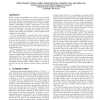Free Online Productivity Tools
i2Speak
i2Symbol
i2OCR
iTex2Img
iWeb2Print
iWeb2Shot
i2Type
iPdf2Split
iPdf2Merge
i2Bopomofo
i2Arabic
i2Style
i2Image
i2PDF
iLatex2Rtf
Sci2ools
ACSAC
2004
IEEE
2004
IEEE
A Dynamic Technique for Eliminating Buffer Overflow Vulnerabilities (and Other Memory Errors)
Buffer overflow vulnerabilities are caused by programming errors that allow an attacker to cause the program to write beyond the bounds of an allocated memory block to corrupt other data structures. The standard way to exploit a buffer overflow vulnerability involves a request that is too large for the buffer intended to hold it. The buffer overflow error causes the program to write part of the request beyond the bounds of the buffer, corrupting the address space of the program and causing the program to execute injected code contained in the request. We have implemented a compiler that inserts dynamic checks into the generated code to detect all out of bounds memory accesses. When it detects an out of bounds write, it stores the value away in a hash table to return as the value for corresponding out of bounds reads. The net effect is to (conceptually) give each allocated memory block unbounded size and to eliminate out of bounds accesses as a programming error. We have acquired sever...
ACSAC 2004 | Buffer Overflow | Buffer Overflow Attacks | Buffer Overflow Vulnerabilities | Security Privacy |
| Added | 20 Aug 2010 |
| Updated | 20 Aug 2010 |
| Type | Conference |
| Year | 2004 |
| Where | ACSAC |
| Authors | Martin C. Rinard, Cristian Cadar, Daniel Dumitran, Daniel M. Roy, Tudor Leu |
Comments (0)

